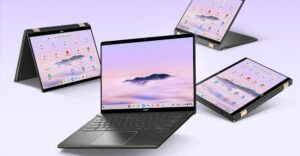
Last week, I was in San Francisco on a panel moderated by Rackable Systems at LinuxWorld, and not only did I walk away alive, I was impressed by the solid work that was being done at the event and amazed at how well Microsoft was fitting in.
The new iMacs were announced, and it is becoming increasingly clear that Apple’s attention for advancement is on the iPod and iPhone and that the PC platforms are just not getting the same attention. Instead of a product of the week this week, given the timing, we’ll chat about getting a back-to-school laptop.
LinuxWorld: Hard Work, No Fanatics and Microsoft Safe
Do you ever have one of those experiences where it feels like you stepped through some Twilight Zone alternative-reality thing? Well, LinuxWorld last week was that kind of experience for me.
It’s been a few years since I last went, and back then it felt like the fanatics were coming out of the walls and open source was the magic term that overcame the fact that much of the technology was nowhere near ready to actually be put into production.
Man, what a difference! My overall sense was that open source no longer carried the near-insane fervor it once did and that people were heavily focused on making sure the vendors actually could do what they promised and had solid examples of those accomplishments.
Simply saying that they’re as good as SAP, or some other vendor — but are open source — wasn’t getting anyone a pass this year, at least as far as I could tell.
Cow Power
My session was talking about the impact of energy-efficient, glass-house computing and I learned a lot. Rackable’s customers, who shared the panel with me, raved about the technology that company has to cut energy costs. We talked about ways to use a combination of utility company rebates and energy savings to get a 100 percent return on investment with new efficient servers and racks, and a better than 40 percent sustainable return through energy savings on the initial hardware costs.
I don’t know of a lot of investments that will provide that kind of return and this would require, in a shared hosting site, that power be a separate monitored charge to work, which isn’t always the case.
It did appear that the best return on this investment would be for those who own the plant. We also talked a lot about next-generation cooling and power, and probably spent too much time talking about using cow manure as a data center power generating fuel source (methane generators). It turns out it takes about 40 cows to produce the fuel daily for one moderate-sized data center. I think we need to get out more often.
Redmond Welcome
Speaking of getting out, Microsoft’s people were very active at the event. I didn’t see or hear of them being booed (though I clearly wasn’t everyplace) and they appeared to be treated with respect throughout. I think Redmond’s current efforts to embrace open source and license appear to be paying off and it sure is a vast difference from the “Get the Facts” days.
Overall, it just feels like more folks are simply trying to get work done and are less interested in OS wars or religious battles. Being a big believer in matching the solution to the product rather than the other way around, I see this as a good thing. I’d go to LinuxWorld again, I learned a hell of a lot, and the people were incredibly nice.
New iMacs Disappoint
I was a huge fan of the second-generation iMac, actually had one for a while. It was unique, ergonomically correct, and vastly different than anything else that ever been in the market.
Today, much like it was with the old IBM Series X41 all-in-one desktop, it remains in my mind one of the very best designs of all time.
Currently, the only PC design Apple offers that I think really stands out is the Mac Mini. While the Mac Pro has a very nice case, its overall look and that of the laptops really isn’t that different. Do you remember how the original Titanium Laptop caught your breath?
Not Really Original
When the third-generation iMac line came out, it looked to me like a copy of an almost identical system that was still being sold in Europe at the time, largely designed for kitchens, and it seemed like a huge step back from the second generation.
The new products, which are basically just the old products re-skinned and cased to reflect the new, more-efficient Intel hardware, have more Intel in them than Apple. After seeing the iPhone, I know Apple can do better, and this video is more along the lines of what I was expecting. Wouldn’t you kill to own an iPhone-like iMac? I saw the video and wanted one yesterday.
I know Steve Jobs has said he didn’t think touch made sense; but then he didn’t think video on an iPod made sense, didn’t think a flash-based iPod made sense, really didn’t think going to Intel made sense, and at least initially didn’t think iTunes on Windows made sense.
I think in virtually every case there were plans in place to make all of these moves when he said they didn’t make sense, so I kind of take Jobs’ comments with a grain of salt now.
What About Touch?
If you look at this video, I just don’t see this kind of experience as being alien to the Mac. Seriously, given the focus on multi-media, isn’t this a natural for apple?
For some time it has looked like the iPod and now iPhone have been given the priority and clearly they are driving Apple’s stock price right now. Even Leopard was slipped so the iPhone didn’t slip and it now will miss the critical back-to-school buying season.
If you look at the HP Touchsmart, while not as attractive, it is more advanced and it is HP design as well. Don’t get me wrong, the Apple product is attractive, very attractive, but it is well short of the kind of amazing work that company has demonstrated time and again and evident in the iPod, the iPhone and the second-generation iMac.
Compared to what Apple could have done with touch, I was disappointed.
It’s Not Apple Computer Anymore
I just wonder if PCs are really that important to Apple anymore. I know a number of folks who have iPhones who think it won’t be long until they won’t need a laptop from anyone — including Apple — so maybe that is the reason. When is the last time anyone saw Steve Jobs with an Apple Laptop?.
Of course with the stock options backdating scandal back in the news, Steve had other issues last week, like the disclosure of a no-confidence vote on his board. How do public companies keep this kind of thing private?
Back-to-School PC
It’s that time again when I make suggestions on shopping for a back-to-school PC. There are four simple rules that can make the experience far better if you follow them:
- Check out the school first. Not only will the people there likely be able to tell you what they will support, but schools get special hardware deals and you can often get a better price (and software load) though the school than at any store. If you get a PC the school doesn’t support, you will likely become technical support yourself. Trust me, that isn’t a lot of fun (though it can assure regular calls from your kid). This is particularly important with firewalls and security software, which the school may supply itself, and the school store will likely have some of the best deals in software anyway. Check the Web, though. Places like Tiger Direct can have deals on the same stuff, so it’s wise to make sure you are getting the best deal.
- Make sure the product purchased matches what the student is likely to be doing. Desktops are less likely to be stolen and provide more performance for the money, but laptops go where the student is and will probably contribute more toward a positive grade. Below 15 inches in screen size, the laptops are focused on being portable, above that size, they are more performance-oriented and the weight does add up. Battery life is important if the school is older, because it might not have enough outlets.
- Get PC Lojack software. This is called Computrace Lojack, and it is by AbosluteSoftware. It may sound like a gimmick, but it actually works, and kids have a habit of leaving expensive stuff around where it can be stolen. If they are staying in a dorm, pick up a Kensington lock so it can at least be locked up when left alone. However, don’t expect this to be used, which is why I recommend the Lojack product.
- Get a backup drive. I’m a big fan of the new Seagate products. There is nothing worse than losing a laptop or losing a hard drive with a semester’s worth of work on it.
Oh, and don’t think you need to spend too much. You can typically get a really nice laptop between US$800 and $1,300 right now, depending on need. Don’t get carried away, and if the kid wants a gaming box, suggest he work a bit for it. It’s a good reason to get some job experience.
Good Luck!
Rob Enderle is a TechNewsWorld columnist and the principal analyst for the Enderle Group, a consultancy that focuses on personal technology products and trends.




















































Enderle said earlier that Apple should exit the hardware business. Absent a review, he’s just taking another lazy swing at Apple. Surely "he" can do better.